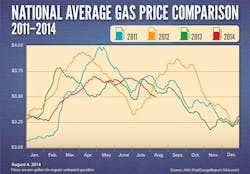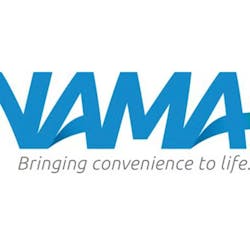(WASHINGTON, August 4, 2014) For the first time since March 12, the national average price for unleaded gasoline has dropped below $3.50 per gallon ($3.4997). Today’s national average is at the lowest level for early August since 2010. The national average has fallen for 37 out of 38 days, and has dropped 18 cents per gallon over this span. Today’s price is two cents less than one week ago, 16 cents less than one month ago and 12 cents less than the same date last year.
Motorists in Hawaii ($4.34), Alaska ($4.11) and California ($3.96) continue to pay the highest prices per gallon for regular unleaded fuel. Last Tuesday (July 29) marked the first time since this spring (March 28) that Californians have paid an average less than $4.00 per gallon at the pump. This decrease is one of 12 states where week-over-week declines of four cents or more were recorded – consumers in Minnesota are experiencing the largest savings per gallon (six cents).
The retail price per gallon fell in 40 states and Washington, D.C over the last seven days, providing the majority of drivers with a bit more relief at the pump. Average prices increased in 10 states, led by Ohio (+10 cents) and Kentucky (+5 cents). Price swings are unfortunately nothing new for Midwesterners, as their states have consistently been among the most volatile in the country. Prices in the region often increase and decrease quickly. While prices have risen slightly over the last week in parts of the Midwest due to refinery problems, many of these same states also lead the nation in month-over-month price decreases: Michigan (-30 cents), Kentucky (-24 cents), Illinois (-24 cents) and Minnesota (-24 cents). Overall, drivers in 48 states and Washington, D.C. have seen prices drop over the last month, with only Wyoming (+2 cents) and Idaho (+4 cents) bucking the trend.
The year-over-year price at the pump is lower in all but four states: Nevada (+9 cents), Colorado (+6 cents), Oregon (+5 cents) and Alaska (+ 4 cents). Last summer, many Midwestern states were in the midst of rollercoaster gas prices due to regional refinery glitches. As a result, of the 46 states and Washington, D.C. where retail prices have dropped, the Midwestern states of Minnesota (-26 cents), Kansas (-26 cents) and Nebraska (-25 cents) lead the nation in year-over-year discounts.
Oil market watchers continue to monitor the Middle East and northern Africa, paying special attention to growing tensions in Eastern Europe. United States and European powers last week announced coordinated sanctions targeting Russia’s long-term ability to develop new oil resources, in response to the country’s involvement in the insurgency in eastern Ukraine. Some have suggested that the latest prohibitions eventually could impact the global supply of crude oil by denying exports of oil industry equipment and restricting Russian state-owned banks from accessing European capital markets. While West Texas Intermediate (WTI) oil prices settled 41 cents higher today at $98.29 per barrel, this marks just a slight increase from Friday’s nearly-six month low of $97.88 per barrel and the first time that WTI has settled below $100 per barrel on three straight days since the start of May.





